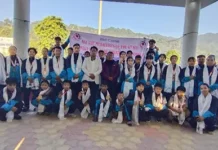[Divya Rathore and Disha S Joshi]
The tiger reserves of India are witness for several centuries to a silent but powerful alliance – a partnership between tribal communities and forest dwellers, and wildlife. Their bond is not just of proximity but a harmonious relationship that has developed, woven through time in culture and tradition. Its most vibrant expression is in the rich collection of tribal art forms – Gond, Warli, Santhal, Bhil, Saura – each offering a mosaic of the dynamic forest ecosystem and the creatures that inhabit it. Distinct in its style and symbolism, tribal art often speaks of its role in protecting forests.
The tiger, the largest of the big cats, is both feared and revered in several Asian societies. It has also, in the last few decades, experienced a threat to its survival. However, in countries such as India, there has been a remarkable increase in the tiger population. Today, India hosts close to 70% of the world’s tiger population.
For generations, the tribal communities have served as guardians of the forest, their own existence connected to the well-being of the natural world they inhabit. For them, the protection of tigers is not just a responsibility imposed, but a cause of deep value that has been passed down through the ages. Indeed, these communities are the original conservationists – they revere the tiger as their deity (Bhagdev, Bhageshwar), their spiritual guide, and for some communities, their sibling in earlier lives.
In 2023, while commemorating 50 years of Project Tiger, the National Tiger Conservation Authority (NTCA) drew attention to this ‘silent but strong’ bond when it collaborated with Delhi-based non-profit Sankala Foundation to mount an exhibition titled Silent Conversation: From Margins to the Centre. At the tribal exhibition, artists from across India showcased their works in celebration of the deep, ancestral connection each felt with the tiger and the ecosystem. The show also included artefacts and offered visitors a unique lens into how these communities live in harmony with forests and wildlife.
This marquee exhibition seeks to change that perception, empowering artists and creating awareness about environmental stewardship. The annual exhibition also has the long-term goal of reducing dependence on forest resources and helping minimise human-wildlife conflict.
In her address, while inaugurating the first edition of the exhibition in 2023, the President of India, Smt. Droupadi Murmu emphasised the value of traditional practices of tribal and forest-dwelling communities, noting that these offer lessons on living a prosperous, contented life in harmony with nature. Subsequently, organisations such as the National Human Rights Commission, India, the Indira Gandhi Rashtriya Manav Sangrahalaya, Bhopal, and the International Big Cats Alliance have partnered in the exhibition, appreciating its purpose and intent.
Besides the legal guarantees, the Government of India has committed to improving the lives of these communities through welfare schemes such as Van Dhan Yojana and economic empowerment through the establishment of Tribal Cooperative Marketing Development Federation of India (TRIFED). Importantly, there is a need to promote their minimalistic way of life as a better model of conservation.
The striking imagery of tribal paintings displays how intricately intertwined the communities are to preservation: their festivals have the tiger as chief guest, and their journeys into the forests are accompanied by the protective force of tigers. Such beliefs have contributed to building a strong conservation ethos among forest communities.
For several artists who regularly showcase their works at the exhibition Silent Conversation, there is new hope. Besides the recognition and sales, the show offers, the artists are confident that their beliefs and conservation ethos will offer a path to many searching for addressing the challenges of wildlife conservation.
When the former President of India Shri Ram Nath Kovind inaugurates the fourth edition of the exhibition in New Delhi on 9 October 2025, the tribal artists around tiger reserves will get a powerful message: From the margins, they have moved to mainstream discourse.
(Divya Rathore is the curator of the exhibition Silent Conversation: From Margins to the Centre. Disha S Joshi is Director, Sankala Foundation Silent Conversation: From Margins to the Centre will be on view from 9 October to 12 October at the India Habitat Centre, New Delhi.)




